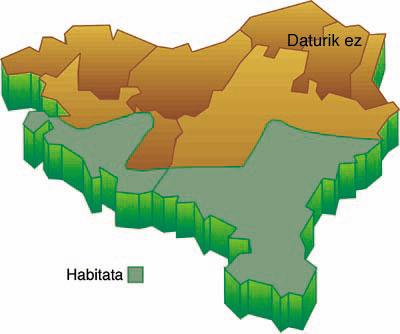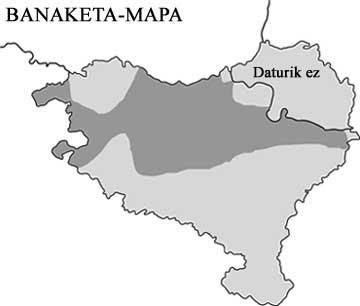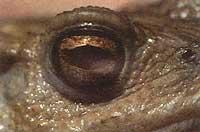Frog, fast and noisy
1994/09/01 Elosegi Irurtia, Migel M. Iturria: Elhuyar aldizkaria
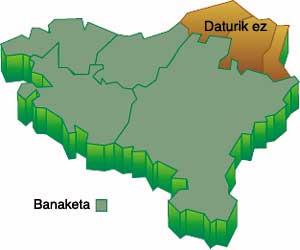
Plasta! News Although it has been very present, I have not been able to see it well and immediately it has been hidden among the strollers of the water. Only 5 more steps and once again “plasta”!! This time yes! It's been a fat green frog and I've seen it kept under a submarine stony. I sat quietly in a back of logs on the banks of the well and a couple of minutes later it has floated over the water, looking at me with its big eyes.
The ancestors of frogs, toads and other amphibians evolved from the sarcoterigians that existed in the Debonic period, and about 400 million years ago they began to live in dry land that until then the vertebrates did not colonize. These animals were released in part from aquatic life, but in addition to keeping their skin always moist, they have to return to wells and streams to fulfill the first steps of life.
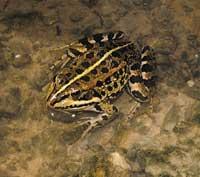
And the ponds, lagoons and rivers are the typical habitat of this skilled jumper. In these wet areas, the frog forms bustling groups (ridiculous frog). Due to its size, it is the largest frog in Europe and, although it usually has a length of 7 10 cm, it can often reach 15 cm, weighing 130 grams. His head is somewhat wider than long and with the sharp end. The two eyes located on the top of the head and close to each other stand out. In them you can see the horizontal pupil and the brown-yellowish iris, with large circular eardrums that easily separate in the head, a little further back. Unlike red frogs and tree frogs, the frog has no temporary dark spots on the eardrum.
The rear legs of the water frog are a powerful tool of spectacular jumps and its five fingers are joined by a membrane that helps to swim. On the dorsolateral part of the inner finger has a small shell that separates it from the other green frogs. The front short legs, on the other hand, have only four fingers and the males, in heat, have adhesive shells that help tie with the female.
The skin of this elegant frog, usually granular, is characterized by two lines of glands on both sides of the back and even the hind legs. Regarding colouring it must be said that it is quite variable. Usually has green and green-brown cover and soft whitish belly. Throughout the body you can see black spots of different sizes, and often highlights a clear vertical green footprint in the center of the back.
Like the rest of amphibians, the adult frog is carnivorous and thanks to its wide mouth can swallow large prey. But if the usual prey is insects, molluscs, arachnids and worms, frog frog can eat tritons, frogs or vertebrates as small fish if caught.
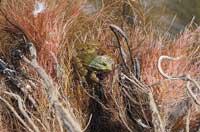
The reproduction of this fast aureo begins with the first sunny and temperate days of spring, and the males, inflating the hoses that have on both sides of the mouth, sound to attract the females and consolidate the territories. With the singing has attracted the female, so the male is placed on it with the adhesive mask that has in his hands, in a position called axillary amplexus. The female will expel from 5 to 10,000 eggs, while fertilizing the males with sperm.
A week after the fall of these eggs will be born cups of 5 mm. These larvae are large with gill breathing and depending on the temperature will take between 3 and 5 months to reach the process called metamorphosis.
In this surprising process, and citing the most spectacular facts, we proceed to the absorption of the tail of the priest and the development of the legs. In turn, many other structures change appearance and function. The branchial respiratory system, for example, is replaced in dry by respiratory lungs and the digestive system suffers profound changes: the small mouth shaped like a beak of the head, the crack becomes extensive and the intestines adapt to a relatively different diet.
Once the appearance of an adult is achieved, despite its much smaller size, the new frog will leave the water and begin to live in the environment of the well.
Because they are poikilothermal metabolisms, they are not able to keep the temperature of their body constant, so when temperatures drop (from November to March or April) they will remain in the lethargy.
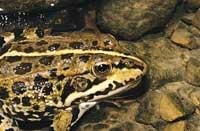
As for the geographical distribution of this municipality, it lives in central and eastern Europe. Visible throughout the Iberian peninsula, although not very abundant in the Atlantic slope. That is what we have in Euskal Herria, and although it can be found throughout the territory, it is much more abundant in the Mediterranean side.
Frog populations have suffered a notable decline in recent years, mainly due to the loss of indispensable wet habitats. In addition, in some areas frogs (especially as breeders) are still captured to eat or sell. Finally, even treading on roads or poisoned with pollution and chemicals die many. Therefore, it is necessary to protect these fragile habitats and reduce other sources of mortality so that the populations of these inhuman invertebrate predators remain in all wetlands.
Species: Ridiculous frog |

Gai honi buruzko eduki gehiago
Elhuyarrek garatutako teknologia



